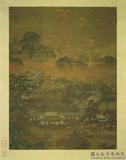明文徵明題宋高宗賜岳飛手勅詞 卷
推薦分享
資源連結
連結到原始資料 (您即將開啟新視窗離開本站)後設資料
- 資料識別:
- 故書000105N000000000
- 資料類型:
- 類型:書法
- 型式:文字
- 著作者:
- 文徵明
- 出版者:
- 數位化執行單位:國立故宮博物院
- 日期:
- 明世宗嘉靖三十八年(1559)
- 格式:
- 隔水一 16.4公分、本幅 46.5x356.6公分、隔水二 16.3公分、拖尾 46.5x295公分
- 語言:
- 漢文
- 關聯:
- 石渠寶笈初編(御書房),下冊,頁938。&*故宮書畫錄(卷一),第一冊,頁110。 &*1.江兆申,〈文徵明題宋高宗賜岳飛手敕詞 卷〉,收入國立故宮博物院編,《吳派畫九十年展》(臺北:國立故宮博物院,1975年初版,1976年再版,1981年三版),頁319。 &*文徵明(西元一四七O-一五五九年),江蘇長洲人。本名壁,字徵明,後以字代名,別名停雲生、衡山居士。詩文書畫俱工,為明四大家之一。其書初學宋元,後法晉唐,各類書體無一不精。依幅後跋文,知吳中沈氏掘地得高宗手勅石刻,文氏為此題詞,薄罪秦檜而歸本于高宗,可謂發千古獨見之言!通篇大字行書,筆力遒勁,結字縱逸,為九十歲離世數日前所書,卻毫無渙散之狀。(20110101)&*Wen Zhengming (native to Changzhou, Jiangsu) excelled at poetry, calligraphy, and painting, being one of the Four Ming Masters. Originally named Bi, he had the style name Zhengming, by which he went later. He also had the names Tingyun sheng and Hengshan jushi. He early followed Song and Yuan dynasty calligraphers, later going back to Jin and Tang masters, and was gifted in all scripts. A colophon for this work says a Mr. Shen of Wuzhong dug up a stone engraving of an imperial order by the Southern Song emperor Gaozong. Wen Zhengming then wrote an inscription, putting more blame on Gaozong than Prime Minister Qin Kui for the demise of the Song, making for a unique historical opinion. In this work of large characters in running script, the brush force is strong yet free and untrammeled. Though written only a few days before Wen passed away at the Chinese age of 90 by, it is not slacking in the least.(20110101)&*文徴明(1470-1559)、江蘇長洲の人。本名は壁、字は徴明、後に字をもって名の代わりとした。別名は停雲生、衡山居士。詩文、書画それぞれに優れ、明四大家の一人に列せられた。その書は初め宋、元代の書法を学んだが、後に晋、唐代の書を手本とし、各書体に精通していた。巻末の跋文によれば、呉中沈が高宗の自書の石刻を発見したことを知り、そのために題詞を書いたという。「(秦檜は奸臣として蔑まれているが、)全ては高宗に帰すのであって、秦檜の罪はそれほど重くない。」正に古今に通じる独自の見解だと言えるだろう。全体に大字の行書で書かれており、力強い筆遣い、伸びやかな結字、90歳でこの世を去る数日前に書いたものだが、いささかも散漫なところがない。(20110101)
- 管理權:
- 國立故宮博物院
授權聯絡窗口
- 國立故宮博物院圖像授權、出版授權、影音資料授權-申請流程說明
http://www.npm.gov.tw/zh-TW/Article.aspx?sNo=03003061






